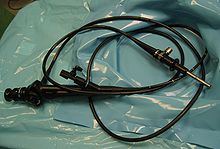Cystoscope
The cystoscope (in earlier times generally cystoscope written; latinized Greek coinage κυστοσκόπιο , literally as "the bubble viewer" of κύστη, kyste "the bladder cyst " and σκοπή, SKOPE "vision, sight") is a special endoscope in the Urology and is used for viewing (“mirroring”) the urinary bladder . This study is called cystoscopy or with investigating the urethra as urethrocystoscopy referred.
history
The development of the cystoscope for a cystoscopy goes back to the Frankfurt doctor Phillip Bozzini . In 1806 he presented the first endoscope as a "light guide" with candle lighting. This development was initially not pursued further. A spéculum urétro-cystique ("urethral bladder mirror") was developed in 1821 by Pierre Salomon Ségalas (1792–1875) and presented in Paris in 1826. The French doctor Antonin Jean Désormeaux (1815–1882), who worked as a surgeon in Paris, presented an endoscope in front of the Academy of Medicine in 1853 that used a mixture of alcohol and turpentine oil for lighting. He carried out numerous examinations of the urethra and the bladder and published the textbook Traité de l'endoscopie in 1865 .
The breakthrough came with the Dresden assistant doctor Maximilian Nitze with the first electrically illuminated cystoscope - at that time still by a water-cooled platinum filament - which he presented in Vienna in 1879 together with the manufacturer Josef Leiter . He published his textbook on kystoscopy in 1889 and the cystographic atlas in 1894 . With cystoscopy , the precise examination and classification of diseases of the urinary bladder began. As a result, the cystoscope was further developed and also allowed the photographic documentation of the examinations made with it. Franz Hoff and Theodor Neeff from the Würzburg University Women's Clinic and Alfred Gütgemann from the Bonn University Surgical Clinic were first able to take useful color images of the human bladder in 1838 . The development of cold light sources represented a significant improvement . With the development of video technology , it became possible to record the examination using a video camera attached to the optics and transfer it to a screen . With the development of new materials and the miniaturization of optical systems, flexible instruments were introduced.
technical structure
There are basically two types of cystoscopes: the rigid cystoscope and the flexible cystoscope. The outside diameter of the instruments is given in Charrière (1 Fr. = ⅓ mm).
Rigid cystoscope
The rigid cystoscope is essentially a multi-part metal instrument . It consists of an outer shaft , an obturator , a tool and an optic .
Flexible cystoscope
The flexible cystoscope is a one-piece instrument with a flexible shaft and a controllable, highly flexible tip. At the top there is a lens that is connected to the eyepiece via glass fibers . There is a combined irrigation and working channel in the instrument.
Literature and Sources
- Werner Staehler: Operative cystoscopy display position and technique of intravesical surgical procedures. Leipzig 1941.
- A. Hegele: Diagnostische Urethrozystoskopie in: R. Hofmann (Ed.) Endokopische Urologie Atlas und Lehrbuch Heidelberg 2005 ISBN 3-540-20679-5
- HJ and MA Reuter: History of Endoscopy. Stuttgart 1997.
- Manfred Skopec, Michaela Zykan: cystoscope. In: Encyclopedia of Medical History. Edited by Werner E. Gerabek , Bernhard D. Haage, Gundolf Keil and Wolfgang Wegner, Walter de Gruyter, Berlin and New York 2005 ( ISBN 3-11-015714-4 ), p. 1535.
Individual evidence
- ^ History.Uroweb
- ↑ Barbara I. Tshisuaka: Desormeaux, Antonin Jean. In: Werner E. Gerabek , Bernhard D. Haage, Gundolf Keil , Wolfgang Wegner (eds.): Enzyklopädie Medizingeschichte. De Gruyter, Berlin / New York 2005, ISBN 3-11-015714-4 , p. 295.
- ↑ Horst Kremling : The cystoscopy - historical considerations. In: Würzburg medical history reports. Volume 11, 1993, pp. 5-8.
- ↑ Friedrich Fromme, Otto Ringleb (Ed.): Textbook of Cystophotography. Your history, theory and practice. Bergmann, Wiesbaden 1913.
- ↑ Horst Kremling: On the development of endovesical color photography. In: Würzburg medical history reports. Volume 2, 1984, pp. 5-7.

